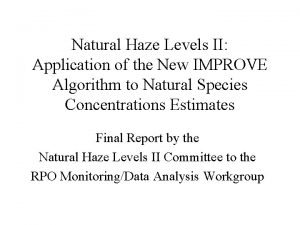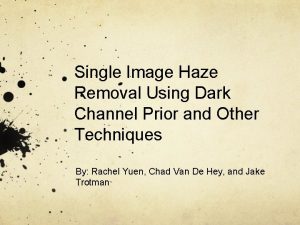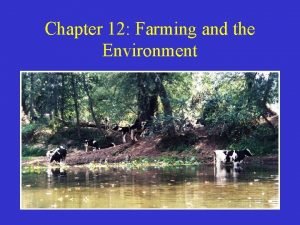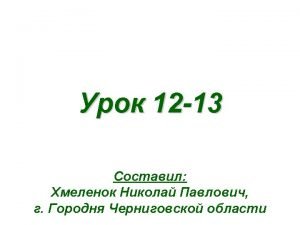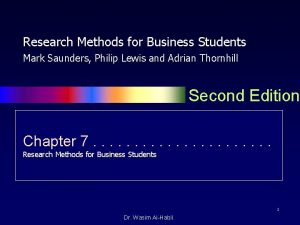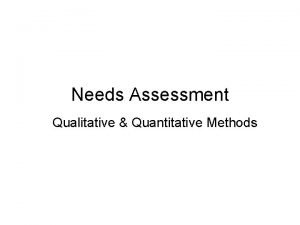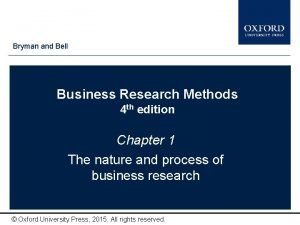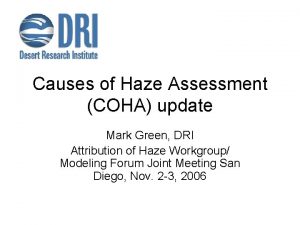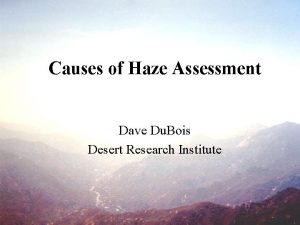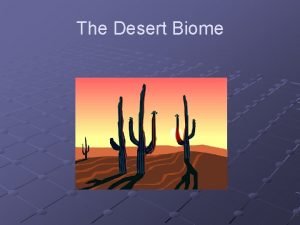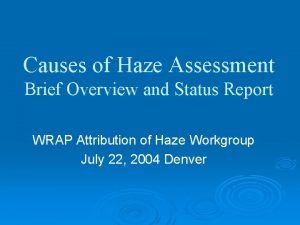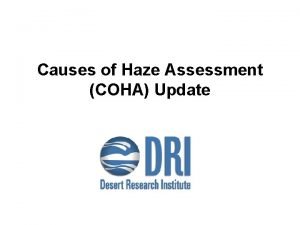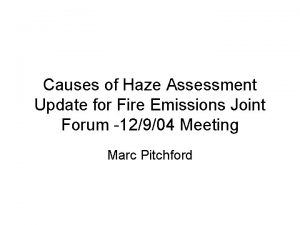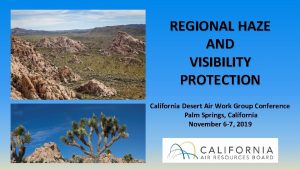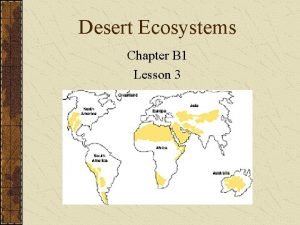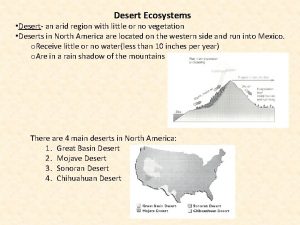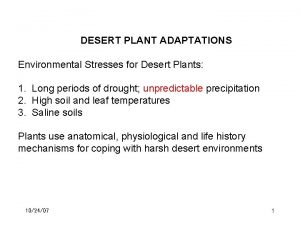Causes of Haze Assessment Mark Green Desert Research































- Slides: 31

Causes of Haze Assessment Mark Green Desert Research Institute Marc Pitchford, Chair Ambient Monitoring & Reporting Forum

Causes of Haze Assessment Goals & Objectives Ü Assess causes of haze for all WRAP Federal Class I Areas on a periodic basis – every five years Ü Encourage broad-based stakeholder participation throughout the assessment process Ü Enhance the utility and accessibility of the results for SIP & TIP development, Regional air quality model evaluation & interpretation,

Causes of Haze Assessment Approach Ü Data analysis methods are selected to respond to a series of questions concerning the causes of haze Ü Will require numerous methods applied to ambient monitoring data, but not regional air quality models Ü As they become available, AMRF reviews draft responses to each question & posts final responses to a web site Ü Results are designed for computer searches, with internal links and directories for an easily

Causes of Haze Assessment Process WRAP/AMRF Causes of Haze Questions Contractor Data Analyses WRAP/AMRF Review Draft Results Each Analysis Method Addresses 1 or More of the Questions Separate Review & Posting for Each Analysis & Question WRAP/AMRF Post Final Results on Web

Each Question is Addressed at Each Class I Areas Grand Mount Lost Canyo Rainier Wood n Question 1 a Question 1 b Question 1 c Question 1 d Question 2 a etc.

Each Analysis Method Addresses One or More Questions Method 1 2 3 Question 1 a Question 1 b Question 1 c Question 1 d Question 2 a etc.

Causes of Haze Assessment Questions Ü What aerosol components are responsible for haze? What are the major components for best, worst & average days & how do they compare? How variable are they episodically, seasonally, interannually? What site characteristics best group sites with similar patterns of major components? How do the relative concentration of the major components compare with the relative emission rates nearby & regionally?

Causes of Haze Assessment Questions - continued Ü What is meteorology’s role in the causes of haze? How do meteorological conditions differ for best, worst and typical haze conditions? What empirical relationships are their between meteorological conditions and haziness? How well can haze conditions be predicted solely using meteorological factors? What site characteristics best group sites with similar relationships between meteorological conditions and haze? How well can interannual variations in haze be accounted for by variations in meteorological conditions?

Causes of Haze Assessment Questions - continued Ü What are the emission sources responsible for haze? What geographic areas are associated with transported air that arrives at sites on best, typical & worst haze days? Are the emission characteristics of the transport areas consistent with the aerosol components responsible for haze? What do the aerosol characteristics on best, typical and worst days indicate about the sources? What does the spatial & temporal pattern analysis indicate about the locations and time periods associated with sources responsible for haze?

Causes of Haze Assessment Questions - continued Ü What are the emission sources responsible for haze? - continued What evidence is there for urban impacts on haze & what is the magnitude & frequency when evident? What connections can be made between sample periods with unusual species concentrations & activity of highly sporadic sources (e. g. major fires & dust storms)? What can be inferred about impacts from sources in other states, other RPOs & other countries? What refinements to default natural haze levels can be

Causes of Haze Assessment Questions - continued Ü Are there detectable &/or statistically significant multi-year trends in the causes of haze? Are the aerosol components responsible for haze changing? Where changes are seen, are they the result of meteorological or emissions changes? Where emissions are known to have changed, are there corresponding changes

Assessment Approach Ü Start with basics, sequentially increase complexity Ü Most thorough effort for 35 WRAP sites with 7 or more years data and 4 long-term CENRAP sites Ü Reduced set of analyses for remaining 44 WRAP sites and 20 CENRAP sites with <3 years of data Ü Descriptive analyses, trajectory analyses,


Period of record for IMPROVE /protocol sites in WRAP region Ü Ü Ü Ü 119 of 156 visibility protected Class I areas in WRAP region, 10 in CENRAP region 78 in WRAP and all 10 in CENRAP have IMPROVE sampler in or nearby Class I area Additional 14 CENRAP sites not at Class I area 3 Class I areas (Grand Canyon, Saguaro, and Yellowstone) have 2 IMPROVE monitoring sites 37 WRAP and 4 CENRAP sites with relatively longterm data, starting between 1988 and 1994 28 sites >10 years data, 9 sites 7 -9 years data (WRAP) Remaining sites started between 1999 and 2002 , 0 -3 years data


Prepare emissions density maps Ü Help in interpreting the aerosol component data; Ü Determine relationship of sources to the Class I areas; Ü Interpreting results of backtrajectory analysis; Ü To examine relationships between mesoscale meteorological transport and efforts of the sources upon Class I areas Ü For CENRAP, need to include emissions east of CENRAP (Midwest RPO, VISTAS)

Describe monitoring sites Ü Their representation of the Class I area and nearby Class I areas; Ü Relationship to terrain features, bodies of water, etc. ; Ü Proximity to major point sources, cities, etc. Information from the emissions compilation described above will be quite useful.

Assess meteorological setting of sites Ü Expected mesoscale flow patterns of interest (sea/land breeze, mountain/valley winds, convergence zones, nocturnal jets, etc. ); Ü Orographic precipitation patterns (i. e. favored for precipitation, or in rainshadow); Ü Inversion layers; Ü Potential for transport from cities and

Aerosol data analysis Ü Descriptive statistics and interpretation for aerosol data- individual components and reconstructed extinction Ü Document, interpret component spatial and seasonal patterns- Best 20%, middle 60%, worst 20% reconstructed extinction days and seasonal patterns by site Ü Compile, describe spatial and seasonal patterns of aerosol components frequency distributions. Ü Interpret aerosol component data in light of emissions sources, monitoring site settings, backtrajectories Ü Cluster analysis to group sites with similar

Backtrajectory analysis Ü Gather backtrajectory endpoint data Ü Compute and map backtrajectory summary statistics residence time by season, best 20% and worst 20% reconstructed extinction and aerosol components for all sites with 5 years or more of data. Ü Prepare conditional probability maps for high and low extinction and aerosol components. Ü Interpret maps using emissions density, location information, site setting information Ü Mesoscale meteorological analysis needed for many sites –backtrajectories will be misleading

Phase 1 conceptual model and virtual report Ü Develop preliminary conceptual models regarding the sources of haze at every Class I area in the WRAP and CENRAP regions + 14 additional sites in CENRAP; Ü Note uncertainties and limitations of the conceptual models; Ü Suggest methodologies to refine conceptual models in next phase of study Ü Make information available over Internet as “virtual report”

Subsequent phases Ü Compile additional meteorological, gaseous, aerosol, emissions, and source profile data as needed to complete remaining tasks Ü Episode analysis -Use combination of backtrajectory, synoptic, mesoscale meteorological analysis, aerosol and emissions data to conceptually understand regional or sub-regional episodes of high

In-depth meteorological analysis Ü Mesoscale flow patterns affecting sites Ü Cluster analysis to group days with similar patterns and examine aerosol components for each cluster Ü Interannual variability of meteorological patterns Ü Diurnal variations in flow patterns, comparison with diurnal variation in optical data.

Emissions changes and receptor modeling Ü Evaluation of changes in emissions since 1988 and relationship to aerosol component concentration changes Ü Source profile analysis- compile source profiles - note changes over time since 1988 Ü Establish chemical abundances against which enrichment factors can be evaluated Ü Use carbon fractions from TOR analysis –can contributions of different carbon sources be distinguished?

Emissions changes and receptor modeling -continued Ü Apply Chemical Mass. Balance (CMB) model Ü Apply Positive Matrix Factorization (PMF) at sites with sufficient periods of record of aerosol data Ü Apply Un. Mix model to aerosol data for each site with sufficient data

Trends and comprehensive assessment Ü Statistical significance tests to determine significance of trends in component concentrations Ü Interpret trends in light of trends in emissions and interannual variability of meteorological patterns- Trend due to emissions or meteorological changes? Ü Comprehensive assessment of causes of haze- all Class I areas + 14 additional CENRAP areas-formulation of refined





 Green green green red
Green green green red What is the correct equation for cellular respiration?
What is the correct equation for cellular respiration? Natural haze
Natural haze Single image haze removal using dark channel prior
Single image haze removal using dark channel prior The soldier decided to desert his dessert in the desert
The soldier decided to desert his dessert in the desert What causes desert
What causes desert Green sahara desert
Green sahara desert Proximate vs ultimate causation
Proximate vs ultimate causation Ultimate and proximate causes of behaviour
Ultimate and proximate causes of behaviour Lernpyramide von green & green (2005)
Lernpyramide von green & green (2005) Green yellow blue
Green yellow blue Frc driver station mac
Frc driver station mac Ac1.2 criminology unit 3
Ac1.2 criminology unit 3 Saunders business research methods
Saunders business research methods Stages in implementing portfolio assessment
Stages in implementing portfolio assessment Define dynamic assessment
Define dynamic assessment Portfolio assessment matches assessment to teaching
Portfolio assessment matches assessment to teaching Quantitative and qualitative difference
Quantitative and qualitative difference Research report vs research proposal
Research report vs research proposal Methodology vs. method
Methodology vs. method What is research design in qualitative research
What is research design in qualitative research Conclusive research methodology
Conclusive research methodology Applied research meaning
Applied research meaning Meaning of research gap
Meaning of research gap Contrast applied research and basic research
Contrast applied research and basic research Sources of a research problem
Sources of a research problem Research instrument in experimental research
Research instrument in experimental research Longitudinal research and cross sectional research
Longitudinal research and cross sectional research Comparative vs. correlational
Comparative vs. correlational Quantitative research instruments
Quantitative research instruments Applied vs fundamental research
Applied vs fundamental research Basic research vs applied research
Basic research vs applied research


